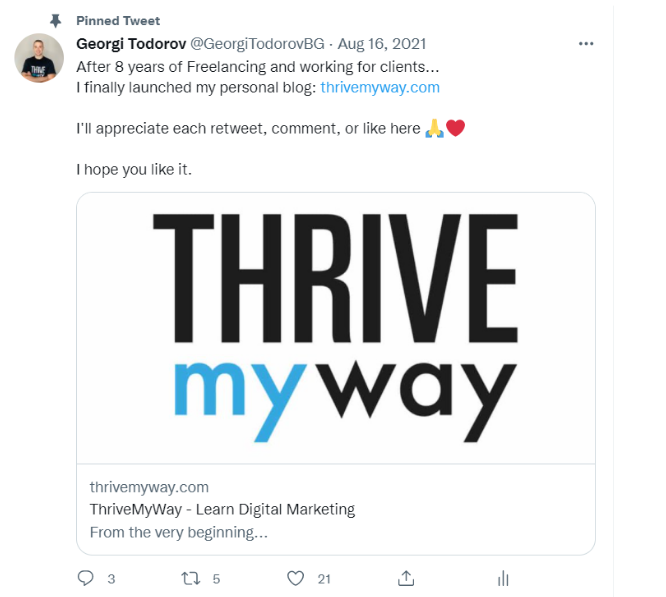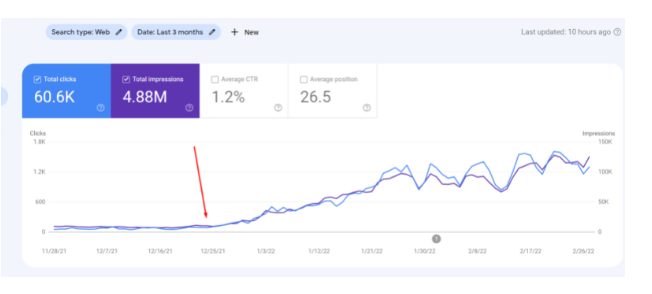In fact, Glassdoor claims that the average full-time blogger can earn on average $52,000 a year. However, for every successful blogger, there are dozens of those that have failed. The reason for this is often that bloggers don’t have the right process to make their websites successful. Having started a blog in the Summer of 2021, I can now say that my blog is very successful. It has grown exponentially recently thanks to the foundations that I put in and the processes that I established. So I wanted to share the seven steps that I took, to make any blog grow quickly, and help you grow your blog regardless of niche or audience.
Step 1: Get the Right Mindset
One of the biggest reasons why those who start blogging fail is that they don’t have the right mindset from the beginning. They create blog posts when they have free time, do as a hobby, or when they get back from work. This is not the right way and most people start to fail. When I lost my job in the Summer of 2021, I decided that I would create ThriveMyWay. But I didn’t want to just post a few things on the web and hope it took off. I had to treat the website as if it was a business. I had to invest time, money, and energy into the blog to ensure that it was a success. So when I announced ThriveMyWay on the 16th of August 2021 with only 10 articles, I knew that I still needed to push for more. I set myself a goal of 200 articles written in two months. I had some savings to ensure that I could do this and I invested some of that into my blog and the articles.
The problem is that many prospective bloggers will start small with 10 or 20 articles. They will publish these and then send 10 or so messages to people on LinkedIn, and Messenger or send a few social media posts out and complain that it doesn’t work. Well, it won’t. You need to be prepared to fail hard and fast and get that done early. If you’re strategic and you treat the blog like a business, you’ve got far more chance of success than you do treating it like a hobby.
Step 2: Decide About Topics and Clusters
The next thing that you need to do is to start thinking about your topics and the clusters. Topics are generalized topics that you will talk about and then you have subtopics within those topics that you expand upon. For instance, I have a pillar post or topic about ‘How to Start a Blog’. I then have lots of mini-topics that are based around that. These are all answering questions that are related to this such as ‘how to write a blog post’, ‘how to promote a blog’, ‘how to make money blogging, etc. The idea of these clusters is to let Google know and start seeing that your blog is an authority on the subject. And you want to cover as many angles on the topic as you can. To help you with this, you can use Google Sheets and keyword search tools to organize and discover the right topics for you.
Step 3: Detailed Article Briefs
Now you need to create detailed article briefs for each article that you’re going to write. When I create detailed article briefs, I create an article on Google Docs that details every heading that I would like to be mentioned and include the keywords and phrases that are to be used, including frequency. You might also want to include any external links that you want to be added as well. In addition, I create video tutorials to demonstrate what I would like from the writer. This is a vital step in the process. If you don’t create a detailed plan, then whoever is going to write the article is going to fail. It doesn’t matter how good they are, if they don’t have a plan, they have no goal to strive for.
Step 4: Hiring Writers
To quickly get to the 200 articles I wanted within two months, I had to get help with the writing. So I hired 10-12 writers from numerous places including Upwork, LinkedIn, and Problogger. The idea is that by hiring numerous writers I could complete the content production phase sooner. There are many talented writers on these platforms and they can often turn around articles very quickly. Having some savings helped me do this, but if you want to succeed, you do need to invest some money into your blog. In addition to hiring writers, you might want to look at hiring an editor. I hired an editor because English is not my first language and I wanted to be sure that everything that I publish is of the best quality. You can find high-quality editors on platforms like Upwork. To ensure all the work is running smoothly, you should look to use Google Docs and Sheets where everyone involved in your blog posts can access the same document. This prevents different versions of the articles from being sent to members of the team.
Step 5: Ensure the Quality of Published Articles
The ultimate success of any blog is on the quality of the writing. For this purpose, there are two elements. The first is ensuring that the writing is of a high standard. With a detailed brief (mentioned in Step 3) and good writers (Step 4), the quality of the writing should be high. However, it is always best to have a professional editor look at the work. I have an editor that would give feedback to all the writers on the work submitted. The writer would then make the required changes and let us know when they’ve been done. The second element is to ensure there is no plagiarism. Plagiarism is a big problem with a website’s authority and you want to use tools like Copyscape to ensure that there is no copied content in any of the articles that are going to be published on your website. I always check to ensure every article is plagiarism-free.
Step 6: Internal Linking with Link Whisper
Internal linking is very important when it comes to traffic and SEO. Internal linking lets Google and other search engines know that you have more to say about a given subject. Therefore, you are seen as a higher authority on the subject. When I started, I wanted to add internal links between all the articles. So I would create links between the pillar post like ‘How to Start a Blog’ to others like ‘How to Promote a Blog’ and so on. Doing this manually is really hard work and it wasn’t rewarding with the amount of traffic that I was getting. There were more than 200 articles, all of them long-form where lots of internal links could be added. So about December, I had to look for another option and that was to use automation with auto-suggestions on internal linking. I decided to purchase Link Whisper. This simple WordPress plugin allows you to find internal links that are relevant as you write and upload your articles. Therefore, you can speed up the process of finding internal links. For me, it made the process so quick and simple. It saved a lot of time and thanks to the plugin, the traffic I got from Google skyrocketed. You can see in the image below the point where I started to use Link Whisper and the traffic just started to increase exponentially.
You can read my detailed review of Link Whisper on my website ThriveMyWay.
Step 7: Taking it Further
Now I am in a position where I can take my blog to the next level. But what does that mean? My blog is receiving lots of traffic and I am ranking high on Google. But to make my blog a success I have to look for ways that I can earn from my blog. There are a few ways that you can monetize your blog and this is dependent on you. Bloggers can use adverts, sponsored content, merchandise, and other options. I am looking to make partnerships with affiliate marketing as a way to monetize my blog. I will also be looking for ways that I can promote the articles to get more traffic and more value from my blogs. But it is important to look at this stage for monetization. This is because you’ve proven that your blog will get views and traffic. It will show potential partners that you’re worth the payment you’re asking for and worth their time in investment. If you do it too early, then sometimes you can find that partners won’t want to talk to you.
Final Word
Above are the seven steps that I took to grow my blog. I did have help throughout the process from a talented pool of writers and my editor to the Link Whisper plugin for my website. But the process works and if you want to be a successful blogger, then it is the process I recommend for you. About







